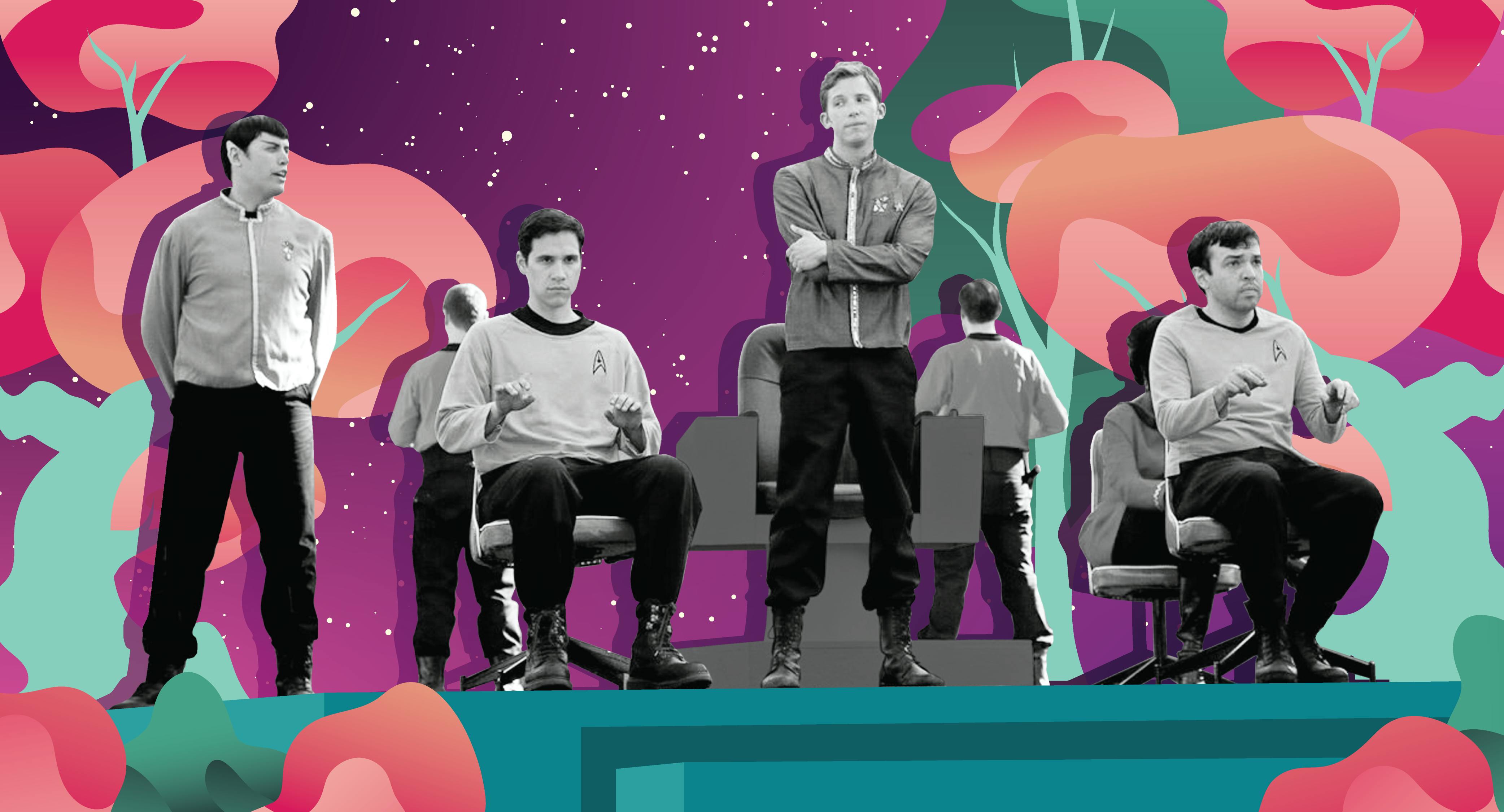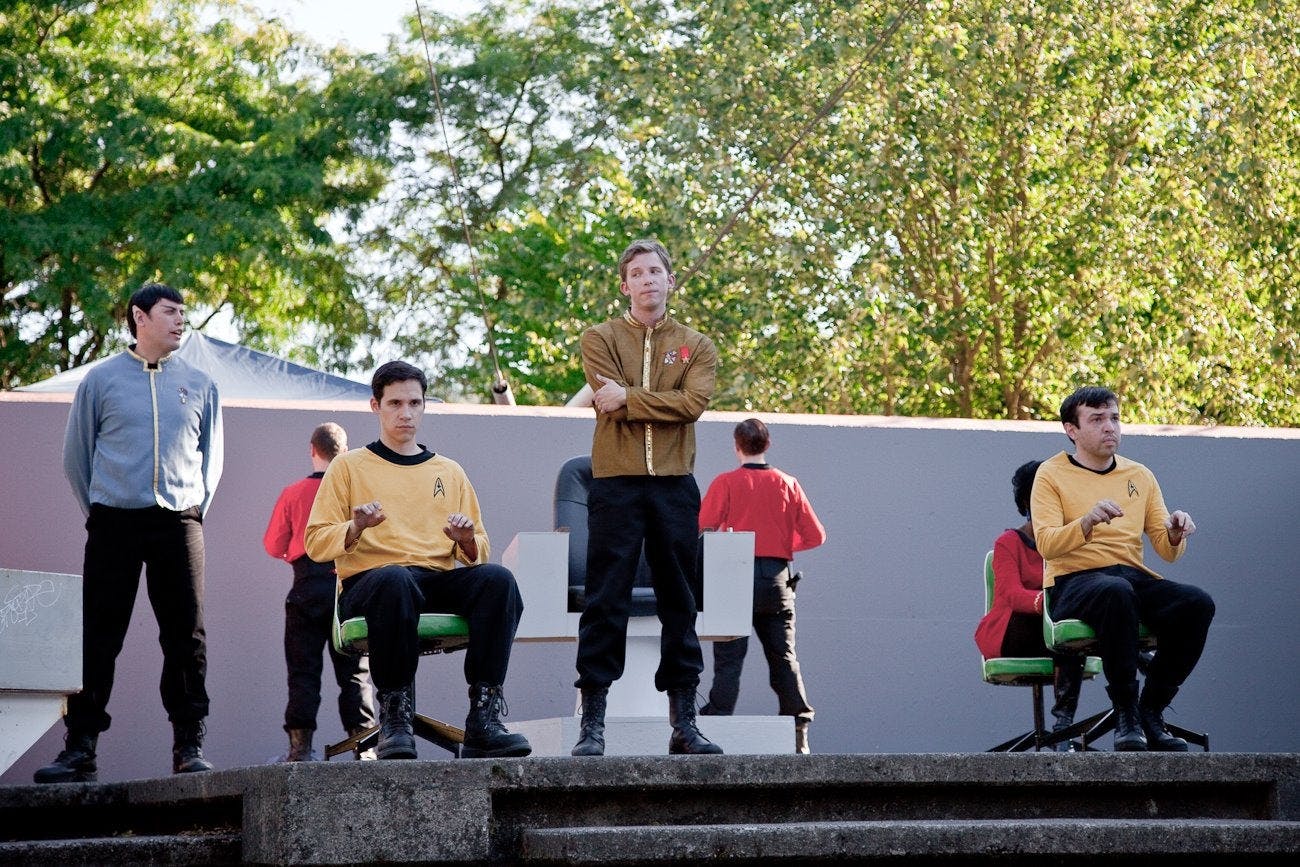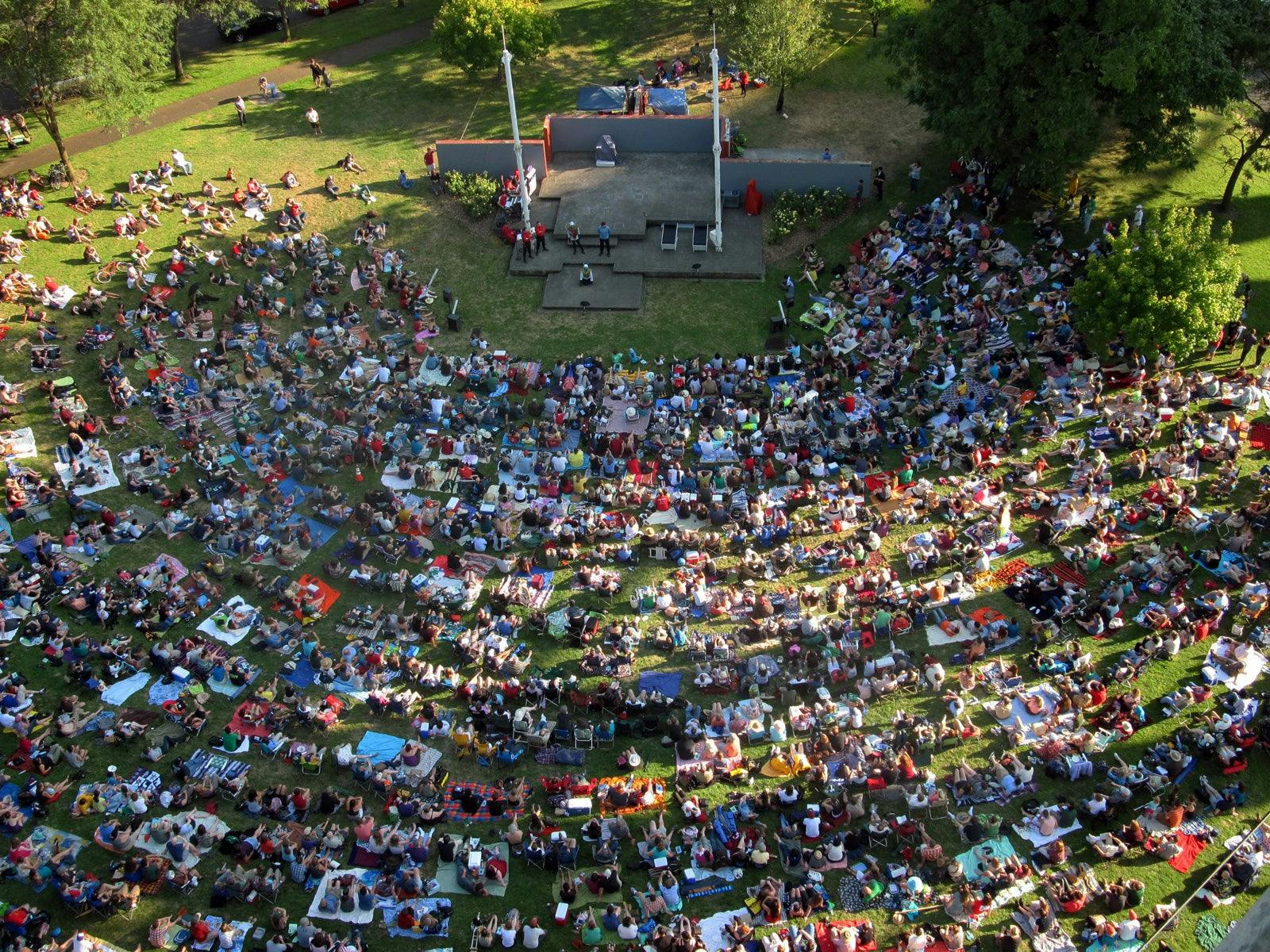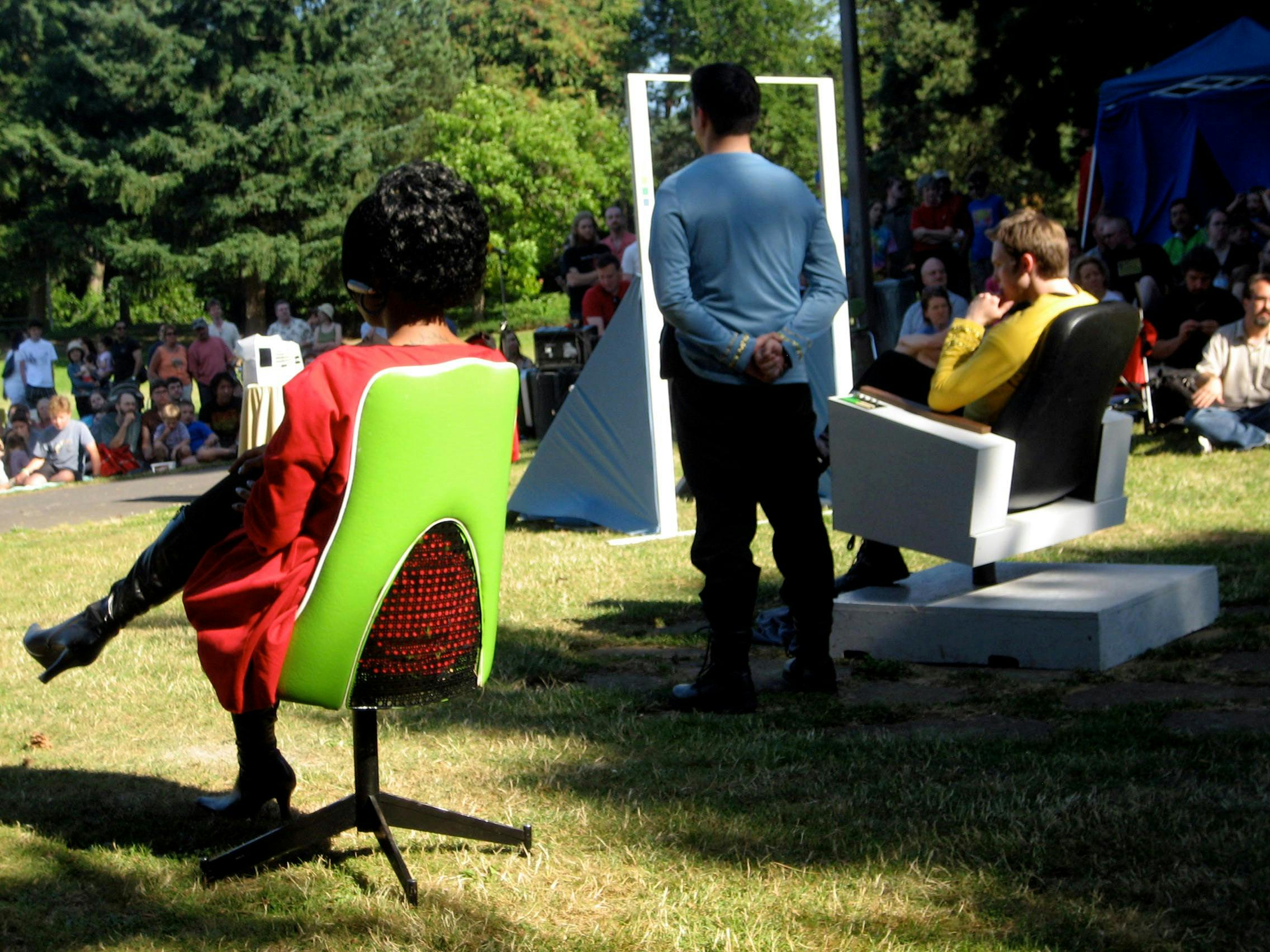Published Aug 13, 2020
The Five Year Mission of Trek in the Park
For five summers, fans in Portland brought Star Trek to life.

StarTrek.com | Merrick Monroe
Here’s the scene: myself and another guard have Kirk by the arms, confident we’ve apprehended this extra-dimensional interloper, when suddenly he breaks free. I take a double axe handle to the midsection and a judo throw across the room, where I am phasered out of existence. Kirk pauses for dramatic effect and the audience claps. I lie still in the freshly-mown grass, breathing in the smell of summer dirt. It is July 2011 and we are putting on a free theatrical adaptation of “Mirror Mirror.”
I’m “Guard #2” and over the course of the show I’ll get knocked out, phasered again, and then vaporized by the mysterious Tantalus field. Me and the other red shirts have neodymium magnets sewn into our tunics so we can swap the Terran Empire’s dagger emblem for the Starfleet chevron when the plot requires. Adapting even a notoriously thrifty TV show like The Original Series requires a hundred clever substitutions for camera cuts and special effects. The bridge crew have a more intricately choreographed costume swap: sleeves come off, midriffs come out, and screen-accurate steel dirks get strapped to every hip.

Merrick Monroe
My first contact with Trek in the Park was two years earlier. An event listing in the Portland Mercury included the words “Star Trek” and “free” and that was enough to get me to a park across town I’d never heard of. What I found was a small stone amphitheater surrounded by a sea of lawn chairs and picnic blankets. At the center was a familiar boxy command chair draped in a sheet. The audience burbled and gossiped until a tinny speaker played that sequence of chimes, the one that comes before “Space: the final frontier.” A man in command gold swaggered out of a nearby tent and delivered a brief speech thanking everyone and requesting pets be kept on leashes.
Year one was “Amok Time”, complete with blaring horns and tearaway battle damage during the Pon Farr ritual. The sets were just the chair and an empty doorframe, but the costumes were vibrant and the acting appropriately big. I was mesmerized, watching these theater kids in primary colors belt out classic ‘60s camp in a quiet city park.
The next year it was “Space Seed” and I got there early to snag a good spot. Within a year Trek in the Park had become a summer ritual for Portland fans and non-fans alike. In between seasons I’d learned some of their names: Captain Kirk was Adam Rosko, an actor from Chicago who’d co-created the production with his sister Amy, who ran the behind-the-scenes. Jessie and Paul were Spock and McCoy, Scotty was Nate, Kaebel and Ryan alternated between Sulu and Chekov episodes. Dana was a punk singer from Kansas City who answered what I presume was a very strange Craigslist post seeking potential Uhuras.
I’m not entirely sure how I got cast as Guard #2 but I suspect it’s because I fit the essential criteria for red shirts: I was stocky, beardless, and unobtrusive. It certainly wasn’t for my acting experience, which was none. Showing up to that first rehearsal in Amy’s backyard was a daunting prospect, and watching the cast and crew banter and snipe felt like walking in on someone else’s family reunion. But after a month of rehearsals I’d memorized my two lines and gotten a feel for stage falls, to the point where if I timed the somersault after the judo throw just right I’d get a neat little backwards skid.
The next year we moved to Portland’s Cathedral Park, which featured a multi-tiered cement stage at the base of a gently sloping hill. Adam and Amy went with “Journey to Babel” for the first show at the new park, an episode that’s not on many top 10 lists. But it’s got everything you’d want in a Star Trek play: weird aliens, ship-to-ship combat, and protracted diplomatic negotiations. For the dramatic blood transfusion scene the production crew created an elaborate contraption complete with green Vulcan blood slowly filling an embedded vial. I played an incidental bridge crewman without any dialogue, but that did mean I got to fly the Enterprise in a few scenes (the console was invisible but I worked out a sequence of button presses).

Dylan Meconis
That was the year things really blew up: the new park could fit thousands of people and we regularly filled it. Voyager’s Garrett Wang flew out one weekend to do a walk-on role and regale us with backstage shop talk. For a little while — in a very regional way — we were a big deal. People lined up to take pictures with us post-show and we started getting recognized in supermarkets (a phenomenon we called getting “trekognized”). It was exhilarating and terrifying, and we ran up astronomical bar tabs after shows regaling each other with our on-and-off-stage antics.
Inevitably we’d get asked what was next, if we’d do The Next Generation or one of the movies, and we’d reply with “It’s a five year mission.” There were only ever a few TOS episodes suitable for the stage (“City on the Edge of Forever” was a contender but it’s all period dress) and anything requiring heavier uniforms was an invitation for heat stroke. It wasn’t clear, even to us, what would come after.
What was inevitable was that we’d do “Trouble with Tribbles” for year five, and that meant tribbles. Lots of tribbles. A few of the “hero” tribbles were store bought, but most were made by the community that had sprung up around us. The Star Trek fandom contains a hidden army of cosplayers, hobbyists and industrious matriarchs, and the result of their combined labors was a screen-accurate mountain of the grain-gobbling critters, many of which still reside in my apartment.
Trials and Tribble-ations
“Tribbles” maintained the streak, thanks to a lot of hard work by the crew and the fact that it’s a nearly perfect episode of television. Garret Wang came out for another weekend. David Gerrold got a chance to see the script he wrote in 1967 delight a live audience 50 years later. With all due humility, we killed it.
And then it was over. The last scene of the last show in the fifth year of the five year mission. We wrapped, we cried, we got very very drunk and that was it. No more summers in space pajamas. There was some talk of doing a followup, something original and high concept, but nothing ever came together. It’d have meant starting over, without the fans who were just there to see Kirk and Spock. In the meantime folks moved on, couples broke up, and we stopped getting recognized in grocery stores. The last time we were all together at the park it was for a funeral, which isn’t how I would have called things in the summer of 2011.

Dylan Meconis
But you don’t sign on to Starfleet for the retirement package. And even though it only lasted a little while in the middle-aughts, we had a hell of a five year mission. Walking around inside those stories gave us some of the magic they had on screen, on stage and off. If there’s one thing I learned from my time as a redshirt, it’s that dying can be an awfully big adventure.
Ben Coleman (he/him) is a freelance writer from Portland, OR and co-creator of The Long Con from Oni Press.

